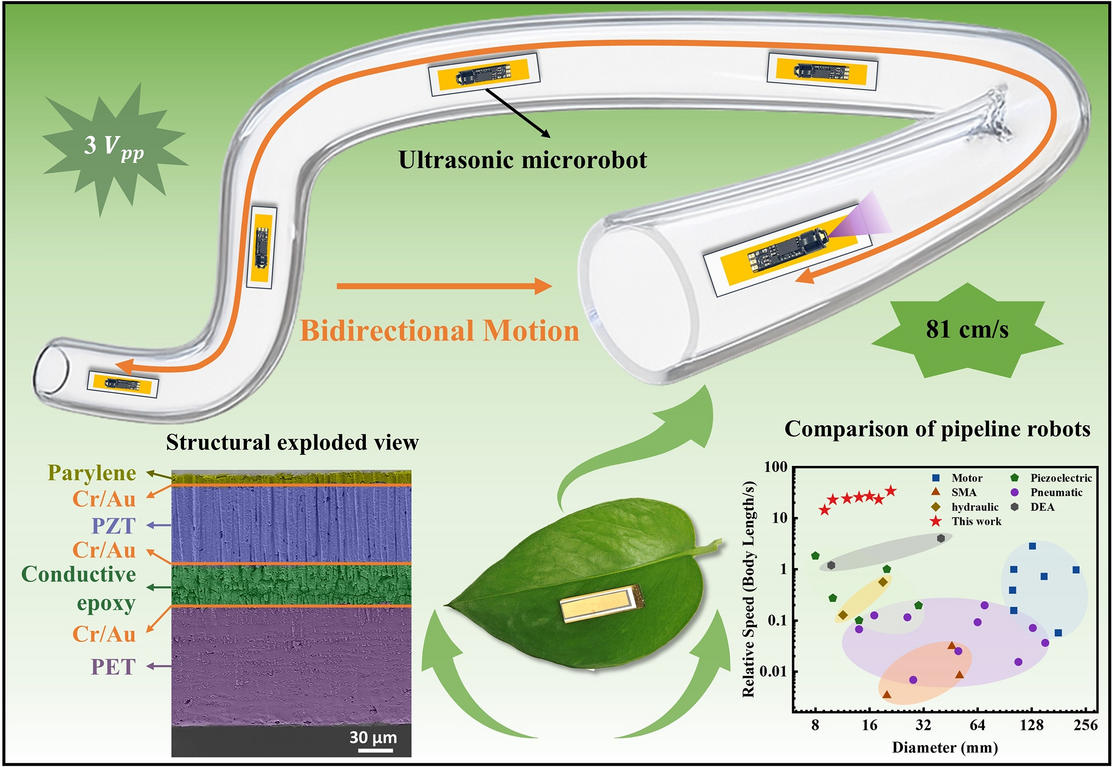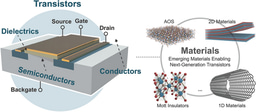An Ultrasonic Microrobot Enabling Ultrafast Bidirectional Navigation in Confined Tubular Environments
Published in Bioengineering & Biotechnology and Materials

A research team led by Professor Bin Yang from Shanghai Jiao Tong University has developed an ultrasonic microrobot capable of ultrafast bidirectional navigation in confined tubular environments, as reported in Nano-Micro Letters. By integrating frequency-modulated ultrasonic actuation with a flexible piezoelectric composite structure, this work sets a new benchmark for miniaturized robotic inspection systems.
Design Concept
- Bio-Inspired Motion: Inspired by the centipede’s retrograde wave gait, the robot converts ultrasonic vibrations into traveling bending waves, generating controllable thrust through frictional coupling with pipe walls.
- Ultrathin Piezoelectric Structure: The robot integrates a thinned lead zirconate titanate (PZT) film with a flexible PET substrate via MEMS fabrication, encapsulated by a parylene-C layer. The compact design (24 mm × 7 mm × 210 μm, 80 mg) ensures high flexibility and adaptability.
- Frequency-Modulated Direction Control: Bidirectional locomotion is achieved simply by tuning the driving frequency, allowing seamless forward and backward motion without structural adjustment.
Performance Achievements
- Record Speed and Low Voltage: The microrobot reaches a maximum speed of 81 cm s-1, surpassing all reported piezoelectric microrobots. It operates at an exceptionally low driving voltage of 3 Vp-p, two orders of magnitude below dielectric elastomer systems.
- High Adaptability: It maintains stable movement in 4 mm-high pipes, climbs slopes up to 24.25°, and carries loads over 36 times its own weight.
- Environmental Versatility: The robot performs robustly in glass, stainless steel, and PVC pipelines, and even moves across water surfaces, demonstrating superior sealing and environmental tolerance.
Functional Demonstrations
- Real-Time Visual Inspection: A micro-endoscope camera enables real-time imaging inside confined pipelines, proving its potential for internal inspection and diagnostics.
- Application Potential: The system offers a powerful platform for pipeline inspection, medical microdevices, and microfluidic monitoring, where compact and agile robots are essential.
Future Outlook
- Toward Autonomous Systems: Future designs will integrate onboard power units, wireless modules, and micro-batteries for untethered, autonomous operation.
- Expanded Capabilities: Combining sensing, imaging, and manipulation functions will transform this design into a multifunctional micro-inspection system.
With its ultrathin architecture, low power demand, and scalable fabrication, this microrobot establishes a foundation for next-generation intelligent microrobotics in industrial and biomedical applications.
Follow the Topic
-
Nano-Micro Letters

Nano-Micro Letters is a peer-reviewed, international, interdisciplinary and open-access journal that focus on science, experiments, engineering, technologies and applications of nano- or microscale structure and system in physics, chemistry, biology, material science, and pharmacy.






Please sign in or register for FREE
If you are a registered user on Research Communities by Springer Nature, please sign in